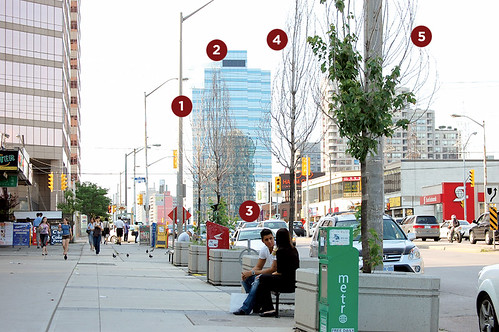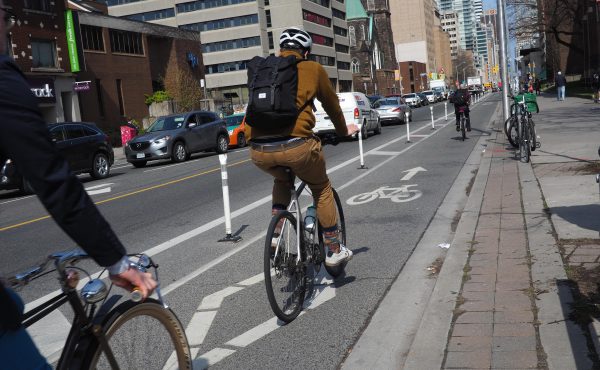
One year ago I posted about a set of five dead or dying trees at the Yonge and Finch intersection (see photo above), and two weeks ago I followed up with another post (see photo below). I’ve gleaned a little more information on the site along with a bit of an update.

In my posts I chastised the City for doing a poor job of maintaining their street-side trees. Councillors like to pose for tree planting ceremonies but when it comes time to budget for tree watering, these same councillors can’t find the cash to do it. I stand by this sentiment, but take back the criticism of this specific site. While the City provided the planter boxes (sometime referred to as “tree coffins” for their lack of space to grow), the unseen Shopper’s Drug Mart store to the left are the culprits here. The masterplan for this part of Yonge calls for the City to provide planter boxes if stores ask for them. Shoppers is in charge of the planting and health of these trees.
So I was surprised to walk on this same stretch of sidewalk only seven days after my second post to discover that all the dead trees had been carted off while new and somewhat healthy looking trees have been planted (photo below). Sounds good right? Well, it’s not.

The trees originally planted were red maples. This type of tree is not well suited for the harsh life of a street-side life. What kind of tree was planted it their place? Red maple. Also of note, the City recommends that trees be planted only in the early summer or wet fall months in order for the roots to absorb as much water as possible. These trees might be in luck this summer with all the rain Toronto has received, but that will not guarantee their long-term health.


11 comments
About four years ago, during one of those blistering, smoggy summers, about 2/3 of the boulevard trees on the eastern edge of the Ryerson campus got fried. There were about 15 of them, roughly 30 feet tall, so not saplings and not too old.
I called Kyle Rae’s office and, to his credit, they were replaced the next spring. What is so irksome though, is that neither the city nor Ryerson could be bothered to water them before they died. It’s so simple, but people prefer to moan about budgets and point fingers. How much did it cost to replace them all? A bit more than watering, I’d guess.
Well Matt, we know this intersection well, it would be amazing that anything could grow in this concrete and asphalt zone. Yonge and Sheppard Street’s are basically a highway along this stretch.
As Hunter says, it is a terrible waste of money to plant trees and then ignore them. The same applies to grass sod, when the city has new sidewalks laid they often have to replace the sod beside it; it MAY be watered once after it’s laid but certainly neither sod nor trees get enough care.
I was recently in Philadelphia and newly planted trees there had some sort of slow release plastic bag attached to their bases – I was told that the City came and filled these up every 2 or 3 days. It is something like a “treegator. See http://www.treegator.com/ DAVID
It’s not all that hard for a concerned citizen to water the darn trees either, but there are far too many sloths in this City to even consider that they would bother.
Easier to bitch and moan.
Curious that they chose Red Maples.
Silver Maple or a variant thereof would not only have been more sensible, but are usually more available too.
Also curious is the design of the boxes for this area, and the watering issue.
In most new developments (downtown condos) the City is now requiring tree pits to be automatically irrigated at the expense of the adjacent property owner.
Tree trenches are also the new norm, or extended size planters than share soil and shrubs for 2 or 3 trees (see the new planters on Yonge St, west side, by Lakeshore.
Also of note is the City’s new experimental sidewalks that are include a sort of permeable feature. This is being done as part of the Queensway reconstruction project.
Sounds like the North York Centre streetscape design manual needs an overhaul.
What is also interesting is that they would plant red maple in such small planters. These are 50 foot trees when full grown. Why are they not choosing smaller species of trees that are more suited to such harsh environments? Makes you think they were never meant to survive.
Actually, Christopher, it would be very difficult for a concerned citizen who lives several storeys up in a high-rise with no access to a ground level water source to water the trees along an entire city block. If it was possible, you can be assured I would have.
The silver maple is a hardy candidate but notorious for being weak wooded as it ages. The city has a mandate to plant native trees, however many of these trees are more suited to the deep soils which hold plenty of nutrients and moisture. A good candidate is the london plane tree which you can see lining many streets in Europe and New York. Not native but hardy to drought, soil compaction and pollution these trees are a good candidate and unlike norway maples, they do not spread into naturalized areas dominating native vegetation. I applaud the use of natives in all appropriate situations but with toronto’s ‘typically’ dry summers and brutal winters I think a reanalysis of the planting pallet is required.
The city should just buy them from a nursery like the rest of us. That way they will get a one year guarantee. [/sarcasm]
When I was a child with Abraham Simpson we planted trees in the earth. : )
Is it really wise for the city to encourage this sort of no-win situation by providing concrete planters? The inevitable result is hunks of concrete filled with litter blocking the sidewalk and depressing everyone with their grey grime.
Toronto should change policies to provide tree PITS upon request, not tree PLANTERS. New York City will break the sidewalk to create a tree pit and drop a tree in it upon request (just fill out their form). Takes a while but in Bloomberg’s New York everything is online and tracked so it does get done eventually.
For more NYC tree-goodness, see their their tree standards. Chock full of useful info.